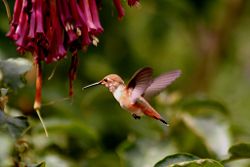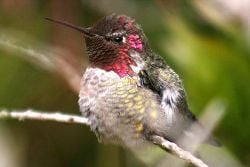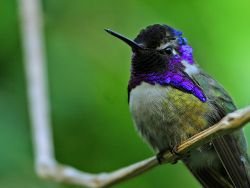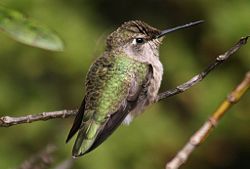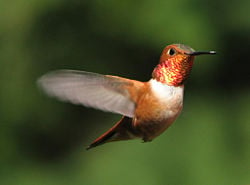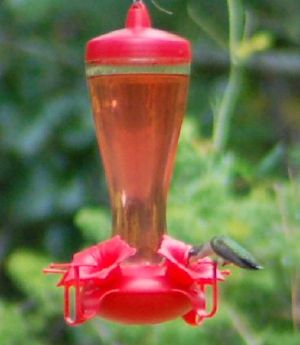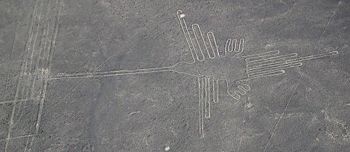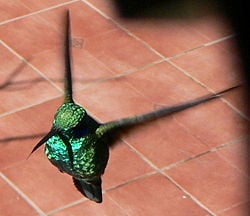Hummingbird
| Hummingbird | ||||||||||
|---|---|---|---|---|---|---|---|---|---|---|
| Scientific classification | ||||||||||
| ||||||||||
|
Phaethornithinae |
Hummingbirds are the smallest of all known birds. They are remarkable for their ability to hover in mid-air by rapidly flapping their wings up to 80 times per second (depending on the species). They are capable of sustained hovering and are the only birds able to fly backwards ( Ridgely et al. 2001) or vertically, and to maintain their position in mid-flight while drinking from flower blossoms. Hummingbirds are named for the characteristic humming sound made by their wings.
The males have a stunningly beautiful iridescent plumage that covers the whole range of colors from red and yellow to green and indigo.
Hummingbirds are attracted to many types of flowers , including shrimp plants, bee balm, heliconia, butterfly bush, hibiscus, bromeliads, cannas, verbenas, honeysuckles, salvias, pentas, fuchsias and penstemons. It is often stated that they are especially attracted to red and yellow flowers. They feed on the nectar of these plants and are important pollinators, especially of deep-throated flowers. Many species of hummingbird also eat insects and spiders.
Breeding
In the male mating flight, the suitor flies several feet above the female,who is sitting on a branch , and dives down toward her , and then comes back up within inches of his intended mate.
Male hummingbirds mate with more than one female,they form no pair bonds and usually take no part in nesting . Most species make a neatly woven cup in a tree branch. The nest may use spider webs,lichens or insect fibers. Two white eggs are laid, which despite being the smallest of all bird eggs, are in fact large relative to the hummingbird's adult size. Incubation takes 14–19 days. The birds leave the nest 20 - 25 days after hatching.
Appearance
The hummingbird is a small bird with a long, thin beak. This elongated beak is one of the defining characteristics of the hummingbird, which, with an extendable, bifurcated tongue, allows the bird to feed upon nectar deep within flowers. A hummingbird's lower beak also has the unique ability to flex downward to create a wider opening, facilitating the capture of insects in the mouth rather than at the tip of the beak (Omara-Otunnu 2004).
The Bee Hummingbird (Mellisuga helenae) is the smallest bird in the world, weighing 1.8 grams and measuring about 5 cm . A more typical hummingbird, such as the Rufous Hummingbird (Selasphorus rufus), weighs approximately 3 g and has a length of 10–12 cm . The largest hummingbird is the Giant Hummingbird (Patagona gigas), which may weigh as much as 24 grams and measure 21.5 cm .
Hummingbirds bear the most iridescent plumage in the entire bird world. They display sexual dimorphism, with male hummingbirds more brightly colored than the females (Camfield 2004). Male plumage may be metallic red, orange, green or blue. Some have only an iridescent cap or throat patch - called a gorget , while others, such as the Coppery-headed Emerald are entirely iridescent (Roberson 2006).
Hummingbird flight
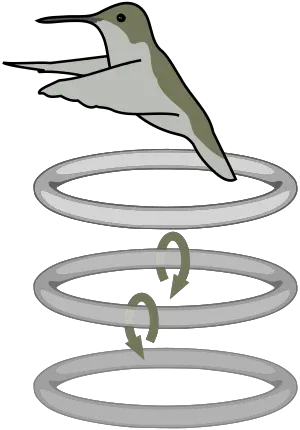
Hummingbird flight has been studied intensively from an aerodynamic perspective . Hovering hummingbirds have been filmed using high-speed video cameras.
The Giant Hummingbird's wings beat 8–10 times per second, the wings of medium sized hummingbirds beat about 20–25 times per second and the smallest species beat 70 times per second with some unsubtantiated reports of speeds up to 200 times per second (Elert 2006 ).
The Rufous Hummingbird, Selasphorus rufus, was studied in a wind tunnel and the lift generated on the bird's upstroke and downstroke was investigated. They concluded that these birds produced 75% of their weight support during the down-stroke and 25% during the up-stroke. This finding shows that a hummingbirds' hovering is similar to, but distinct from, that of hovering insects such as the hawk moths ( Warrick et al. 2005)
Long tailed hermit hummingbirds were clocked at an average speed of 25.7 mph along a 40 meter course. Others found that Ruby - throated hummingbirds could could not make any progress in a wind tunnel with a headwind of 26 mph(Gill 1985), so this would seem to be their maximum flight speed.
Metabolism
With the exception of insects, hummingbirds , while in flight , have the highest metabolism of all animals, a necessity in order to support the rapid beating of their wings. Their heart rate can reach as high as 1,260 beats per minute, a rate once measured in a Blue-throated Hummingbird (Chambers 2007). They also typically consume more than their own weight in food each day, and to do so they must visit hundreds of flowers daily. They are capable of slowing down their metabolism at night, or any other time food is not readily available. They can enter a hibernation-like state known as torpor , in which the heart rate slows to 50 to 180 beats per minute. Their rate of breathing can also slow dramatically .
Range
Hummingbirds are found only in the Americas, from southern Alaska and Canada to Tierra del Fuego, including the Caribbean. The majority of species occur in tropical Central and South America, but several species also breed in temperate areas. Excluding vagrants, sometimes from Cuba or the Bahamas, only the migratory Ruby-throated Hummingbird breeds in eastern North America. The Black-chinned Hummingbird, its close relative and another migrant, is the most widespread and common species in the western United States and Canada.
A migrating Ruby-throated Hummingbird can cross the 500 mile stretch of the Gulf of Mexico on a nonstop flight ; a trip estimated to take about 20 hours. This hummingbird, like other birds preparing to migrate, stores up fat to serve as fuel, thereby augmenting its weight by as much as 40–50 percent and hence increasing the bird's potential flying time ( Skutch et al. 1973)
Most hummingbirds of the U.S. and Canada migrate to warmer climates in the northern hemisphere winter, but some remain in the warmest coastal regions. Some species in southern South American move to the tropics during the southern hemisphere winter.
The Rufous Hummingbird shows an increasing trend to migrate east to winter in the eastern United States, rather than south to Central America, possibly because of artificial feeders provided by hummingbird lovers . In the past, individuals that migrated east would usually die, but now many survive, and their changed migration direction is transferred to their offspring. Provided sufficient food and shelter is available, they are surprisingly hardy, able to tolerate temperatures down to at least -4° F.
Systematics and evolution
Traditionally, hummingbirds were placed in the order Apodiformes, which also contains the swifts. In the Sibley-Ahlquist taxonomy, hummingbirds are separated as a new order, Trochiliformes, but this is not well supported by evidence. Hummingbirds' wings are hollow and fragile, making fossilization difficult and leaving their evolutionary history a mystery. Some scientists also believe that the hummingbird evolved relatively recently. Scientists also theorize that hummingbirds originated in South America, where there is the greatest species diversity. Brazil and Ecuador contain over half of the known species.
There are between 325 and 340 species of hummingbird, depending on taxonomic views, that are divided into two subfamilies :(1) Phaethornithinae (the 'hermits') and (2) Trochilinae ( typical hummingbirds). The Phaethornithinae consist of 6 genera with about 34 species and the Trochilinae consist of 101 genera with about 306 species.
The modern diversity of hummingbirds is thought by evolutionary biologists to have evolved in South America, as the great majority of the species are found there. However, the ancestor of extant hummingbirds may have lived in parts of Europe in what is southern Russia today.
Genetic analysis has has led to speculation that the hummingbird lineage diverged from their closest relatives some 35 million years ago, in the Late Eocene, but fossil evidence is limited. Fossil hummingbirds are known from the Pleistocene of Brazil and the Bahamas—though neither has yet been scientifically described . There are fossils and subfossils of a few extant species , but until recently, older fossils had not been securely identifiable as hummingbirds.
In 2004 , two 30-million-year-old hummingbird fossils were identified (Mayr 2004). The fossils of this primitive hummingbird species were named Eurotrochilus inexpectatus ("unexpected European hummingbird") . They had been sitting in a museum drawer after they had been unearthed in Germany. But because it was assumed that hummingbirds never occurred outside the Americas, they were not recognized as hummingbirds until Mayr took a closer look at them.
Fossils of birds not clearly assignable to either hummingbirds or a related, extinct family, the Jungornithidae, have been found at the Messel pit and in the Caucasus, dating from 40–35 million years ago (m.y.a.), indicating that the split between these two lineages indeed occurred at that date. The areas where these early fossils have been found had a climate quite similar to the northern Caribbean or southernmost China during that time. The biggest remaining mystery at the present time is what happened to hummingbirds in the roughly 25 million years between the primitive Eurotrochilus and the modern fossils. The astounding morphological adaptations, the decrease in size, and the dispersal to the Americas and extinction in Eurasia all occurred during this timespan. DNA-DNA hybridization results suggest that the main radiation of South American hummingbirds at least partly took place in the Miocene, some 12–13 m.y.a., during the uplifting of the northern Andes (Bleiweiss et al. 1999).
Hummingbirds and humans
Hummingbirds sometimes fly into garages and become trapped. Once inside, they may be unable to escape because their natural instinct when threatened or trapped is to fly upward. This is a life-threatening situation for hummingbirds and they can become exhausted and die in a relatively short period of time, possibly as little as an hour. If a trapped hummingbird is within reach, it can often be caught gently and released outdoors. It will lie quietly in the space between cupped hands until released.
Hummingbirds have been photographed feeding from a container of sugar water while perching on people. These birds will also hover within inches of people in order to feed.
Feeders and nectar
The diet of hummingbirds consists of nectar and a protein source eg. small insects or spiders. The safest way to provide nectar for hummingbirds is to plant many flowers that they will visit . Through careful planning , gardens may contain plants that bloom at different times to attract hummingbirds throughout the seasons. Placing these plants near windows affords a good view of the birds. Hummingbirds will eat synthetic nectar from artificial feeders. Such feeders allow people to observe and enjoy hummingbirds up-close while providing the hummingbirds with a reliable supply of nectar, especially when flower blossoms are less abundant. Maintaining cleanliness of the feeder is essential for the health of the birds. Homemade nectar can be made from a 20% solution of granulated table sugar in boiling water .
Avoid using honey in feeders because it may contain bacterial spores dangerous to hummingbirds . Artificial sweeteners should also be avoided because, although the hummingbirds will drink it, they will not receive the calories they need to sustain their metabolism. Some commercial hummingbird foods may contain red dyes and preservatives,which shold be avoided. Commercial nectar mixes are usually not useful . Artificial nectar once placed outdoors will only remain fresh for a few days before microbial spoilage.
It is a good idea to get a feeder that has very narrow ports, or ports with mesh-like "wasp guards", to prevent bees and wasps from getting inside. Orioles, woodpeckers, banaquits, and other animals are known to also drink from hummingbird feeders. Ants may also compete for the sugar water.
Sometimes a larger hummingbird will drive away the smaller ones from a feeder. An effective solution is to put out a second feeder that contains a slightly lower sugar concentration. Hummingbirds can detect a feeding source that is denser in sugar by only a few percent, and the more aggressive bird will make the more concentrated feeder its own and allow the smaller birds to eat from the other more dilute feeder.
In myth and culture
- The Aztec god Huitzilopochtli is often depicted as a hummingbird. The Nahuatl word huitzil (hummingbird) is an onomatopoeic word derived from the sounds of the hummingbird's wing-beats and zooming flight.
- One of the Nazca Lines, displayed at right, depicts a hummingbird.
- The Ohlone or Costanoan people tell stories of hummingbirds and coyotes ( Kroeber 1907 ). Linda Yamane ,a Rumsien Ohlone ,has written about the role of hummingbirds in ancient myth (Yamane 1995).
- Trinidad and Tobago is known as "The land of the hummingbird," and a hummingbird can be seen on that nation's coat of arms,1 cent coin as well as its national airline, "Caribbean Airlines".
- In Brazil a black humming bird of any kind is a sign of death in the family, especially inside the house.
ReferencesISBN links support NWE through referral fees
- Bleiweiss ,R. , J. A. W. Kirsch and J. C. Matheus . 1999. DNA-DNA hybridization evidence for subfamily structure among hummingbirds. Auk 111(1): 8–19. PDF fulltext
- Camfield , A. 2004. Trochilidae , Animal Diversity Web. [1] accessed Aug. 9, 2007
- Chambers ,L. 2007. About Hummingbirds.[2]. accessed on Aug 11,2007.
- del Hoyo, J., A. Elliott, J. Sargatal, (editors) 1999. Handbook of Birds of the World, Volume 5: Barn-owls to Hummingbirds. Lynx Edicions, Barcelona. ISBN 84-87334-25-3
- Elert,G. 2006. Frequency of Hummingbird Wings. The Physics Factbook™ .accessed on Sept 5,2007
- Gerwin , J.A.,R. M. Zink . 1998 . Phylogenetic patterns in the Trochilidae. Auk 115(1): 105-118. [3]
- Gill, F.B. HUMMINGBIRD FLIGHT SPEEDS. Auk 102 (1): 97-101.
- Kroeber ,A. L. 1907 . C3.—RUMSIEN COSTANOAN. COYOTE AND THE HUMMINGBIRD :199-202. in Indian Myths of South Central California , University of California Publications in AMERICAN ARCHAEOLOGY AND ETHNOLOGY .VOL. 4 NO. 4[4]
- Mayr,G. 2004 . Oldest hummingbird fossil found.[5]
- Omara-Otunnu, E. 2004. Hummingbird's Beaks Bend To Catch Insects ,Advance,University of Connecticut ,[6]].accesed Aug.9,2007
- Rayner, J.M.V. 1995. Dynamics of vortex wakes of flying and swimming vertebrates. J. Exp. Biol. 49:131–155.
- Ridgely ,R.S. and P.G. Greenfield . 2001 . "The Birds of Ecuador: Field Guide",volume 2 , Cornell University Press.
- Roberson ,D. 2006 . CREAGRUS@ Monterey Bay [7] accessed Aug. 10,2007
- Meyer de Schauensee , R. 1970. A Guide to Birds of South America. Wynnewood, PA. : Livingston
- Skutch, A. F. and A. B. Singer. 1973 . The Life of the Hummingbird. New York : Crown Publishers . ISBN 0-517-50572-X
- Warrick, D. R. ,B.W. Tobalske and D.R. Powers . 2005 . Aerodynamics of the hovering hummingbird. Nature 435: 1094–1097 .DOI:10.1038/nature03647
- Yamane , L. 1995 . When the World Ended, How Hummingbird Got Fire, How People Were Made: Rumsien Ohlone Stories. Published by Oyate .ISBN-13: 9780962517518.
External links
- historical references to hummingbirds[8]
- oholone hummingbird tales : ; also Kroeber, 1925:472-473. Chochenyo Kaknu tales, Bean (Harrington), 1994:106.</ref>
- frequency of hummingbird wingbeats [9]
- [10] National Georgrphic magazine artile on hummingbirds
- The Official Hummingbird Forum
- Hummingbirds.net
- The Hummingbird Society
- Ruby Throat Hummingbird Project
- Ecuador Hummingbirds and Climate Change
- Hummingbird species
Credits
New World Encyclopedia writers and editors rewrote and completed the Wikipedia article in accordance with New World Encyclopedia standards. This article abides by terms of the Creative Commons CC-by-sa 3.0 License (CC-by-sa), which may be used and disseminated with proper attribution. Credit is due under the terms of this license that can reference both the New World Encyclopedia contributors and the selfless volunteer contributors of the Wikimedia Foundation. To cite this article click here for a list of acceptable citing formats.The history of earlier contributions by wikipedians is accessible to researchers here:
The history of this article since it was imported to New World Encyclopedia:
Note: Some restrictions may apply to use of individual images which are separately licensed.
